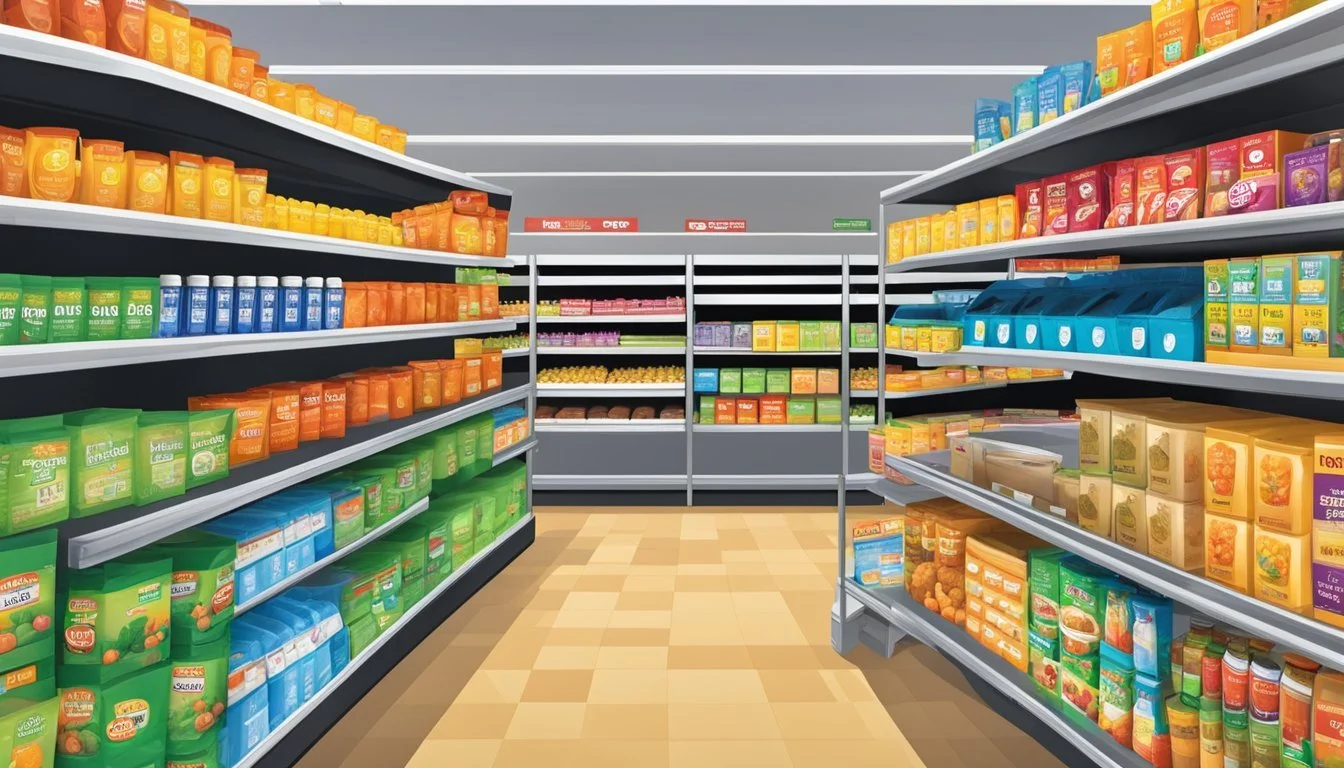Is H-E-B Cheaper Than Stop & Shop?
Comparing Grocery Store Prices
Part of Our Grocery Store Guide with Details on H-E-B Prices and Stop & Shop Prices
When considering the cost of groceries, supermarket chains H-E-B and Stop & Shop often come under scrutiny by budget-conscious shoppers. H-E-B, a well-regarded Texas-based chain, has established a stronghold, particularly in regions like San Antonio, offering a variety of private label collections, organic products, and competitive online services. With its focus on maintaining a cost-efficient operation, H-E-B captures the loyalty of Texan consumers through both its in-store experience and pricing strategies that are perceived to provide genuine value for money.
Stop & Shop, on the other hand, operates predominantly in the Northeastern United States and has a reputation for being a convenient option for a wide range of grocery needs. Regular sales and promotions are part of Stop & Shop's strategy to attract and retain customers, and the store often features a considerable number of items, including its own store brand, at discounted prices. For budget-savvy shoppers, comparing the two supermarkets involves looking beyond the sticker prices, considering the overall quality, the range of products offered, and the shopping experience each store prides itself on.
A direct comparison of the two, H-E-B and Stop & Shop, entails analyzing various factors such as pricing, product variety, and regional availability. While Stop & Shop might come out ahead in certain areas or product categories, H-E-B's dedication to keeping costs low for its clientele often reflects in its competitive pricing model. It's this intricate balance of cost, convenience, and quality that consumers weigh when determining which supermarket offers the better deal.
Comparing Supermarket Pricing Strategies
In the context of H-E-B and Stop & Shop, two prominent grocery stores, it is critical to understand their distinct approaches to pricing. Factors like regional influence, brand types, and competitive pressures shape these strategies significantly.
Understanding Regional Pricing Differences
H-E-B, primarily operating in Texas, tailors its pricing to this region. It leverages local conditions, such as proximity to suppliers and regional demand, to offer competitive prices. Stop & Shop, with a strong presence in the Northeast, adapts its pricing to the cost structures and consumer spending patterns typical of this region. For instance, a San Antonio-based H-E-B might price products differently than a Stop & Shop in Boston due to variations in local market economies.
Private Labels vs. National Brands
Both H-E-B and Stop & Shop offer an array of private labels, which allow for significant savings compared to national brands. H-E-B's private label items are priced lower, providing an alternative to national brands and passing on savings to consumers. Stop & Shop follows a similar strategy, positioning their store brands as value offerings compared to well-known names.
National Brands: Higher priced, widely available.
Private Labels: Cost-effective, often store-specific.
Impact of Retailer Competition on Prices
The retail market includes players like Walmart and Amazon, against which H-E-B and Stop & Shop must competitively price their products. Competition in the retail sector leads to strategic pricing to offer the best value and attract customers. H-E-B might roll out exclusive deals to compete with Walmart's low prices, while Stop & Shop could provide savings opportunities through loyalty programs to counter Amazon's convenience factor.
Deals and Savings: Employed to attract and retain customers.
Competitive Retailer Landscape: Walmart, Amazon, and other supermarkets influence pricing strategies.
By examining these specific factors, one can better understand how H-E-B and Stop & Shop navigate the supermarket landscape to offer value to their customers through strategic pricing.
Quality and Value Proposition
When comparing H-E-B with Stop & Shop, it is essential to consider both the quality of products offered and the value for money that shoppers can expect from these grocery stores.
Assessing Product Quality
H-E-B prides itself on a strong commitment to providing high-quality goods, including a variety of organic, gluten-free, and locally-sourced produce. Their focus on freshness is evident in their meat and produce sections, which frequently boast a wide selection of premium, organic options. In contrast, Stop & Shop also offers a robust selection of similar quality products, catering to health-conscious consumers with an emphasis on organic and gluten-free products.
Organic Selection: Both supermarkets offer a range of organic fruits, vegetables, and meat, ensuring customers have access to healthier, chemical-free options.
Private Labels: H-E-B's private labels are known for their quality, often matching or exceeding the standard of national brands. Stop & Shop similarly promotes its own private label items, ensuring quality at reduced prices.
Value for Money Evaluation
In terms of value, both H-E-B and Stop & Shop strive to offer competitive low prices and savings without compromising on quality. H-E-B is renowned for its deal offerings and low prices, especially on its private label products, which allows customers to enjoy significant savings. They frequently run promotions that provide real value to the budget-conscious shopper.
On the other hand, Stop & Shop is committed to value through their loyalty programs and weekly deal circulars, which highlight savings on a variety of products throughout their stores. While they may not always have the lowest prices across the board, the supermarket frequently offers deals that make their grocery items more affordable.
Deals and Savings:
H-E-B: Offers weekly deals, bulk savings, and meal deals.
Stop & Shop: Provides savings through loyalty programs and weekly advertisements.
Private Label Savings:
H-E-B: Often cheaper due to the emphasis on in-house brands.
Stop & Shop: Competes with its own range of quality private label products.
In examining both supermarkets, shoppers can expect an array of quality products geared towards healthy lifestyles and savings, reflective of a strong value proposition.
Assortment and Availability
In evaluating the assortment and availability at H-E-B and Stop & Shop, it’s essential to consider the diversity of their grocery selection, private label offerings, and the range of specialty and international products each store carries.
Diversity of Grocery Selection
H-E-B boasts a large selection of grocery items, from staples like milk, eggs, and bread to a variety of chips and pasta. Their offerings are extensive, meeting the demands of a diverse consumer base, which includes a wide assortment of gluten-free products. Stop & Shop also offers a broad selection, but its diversity may vary based on location, with some stores offering more ethnic and international products.
Private Label Offerings
Both H-E-B and Stop & Shop have robust private label lines, providing shoppers with a selection of goods that often compete with national brands in terms of quality and price. H-E-B’s private labels, such as Hill Country Fare and H-E-B Organics, are popular for their affordability and quality. Stop & Shop’s own brands offer similar value, with an emphasis on everyday value.
H-E-B Private Labels
Hill Country Fare: cost-effective basic necessities
Primo Picks: unique and high-quality selections
Central Market: gourmet options
H-E-B Organics: organic product line
Stop & Shop Private Labels
Nature's Promise: natural and organic foods
CareOne: health and beauty products
Specialty and International Product Lines
Shoppers at H-E-B can enjoy a range of specialty items, such as the Central Market line which caters to gourmet and international tastes. H-E-B Plus stores elevate this selection further, featuring expanded departments for beauty and home goods. Conversely, Stop & Shop maintains a selection of international cuisines, though the extent is often dependent on local demographics. Both retailers accommodate the growing demand for gluten-free options in numerous categories.
Shopping Experience and Convenience
When comparing H-E-B and Stop & Shop, it's essential to consider the ease of navigating the stores, the efficiency of the checkout process, and the convenience offered by online shopping and delivery options each chain provides.
Store Layout and Navigation
H-E-B stores typically offer a spacious layout with an average size of around 70,000 square feet. This allows for an extensive selection of products and a layout that can facilitate easy navigation for shoppers. H-E-B also focuses on product organization that aims to enhance the shopping experience by logically grouping items.
Stop & Shop offers an experience that tends to vary by location. They have pushed toward making stores more navigable and shopper-friendly in an effort to keep up with customer preferences for store ease of use.
Checkout and Payment Process
Stop & Shop features traditional checkout lines, self-checkout stations, and the Scan It! mobile app, allowing customers to scan and bag items as they shop for a faster checkout. The app can also lead to saving opportunities as it provides personalized offers.
H-E-B stores have embraced a similar approach to checkout convenience, typically providing self-checkout options to speed up the payment process for its customers. Efficient checkout is one of the cornerstones of H-E-B's strategy to improve customer satisfaction.
Online Shopping and Delivery Options
H-E-B's investment in their online grocery experience has been significant, earning them recognition for their user-friendly website and efficient curbside pickup services. They have a threshold for free pickup, and a small fee is attached to orders under $35. The company expanded these services due to increased demand during the pandemic, allowing them to offer greater convenience to their customer base.
Stop & Shop has also stepped up its online presence with Peapod, the online grocery service that enables customers to order their groceries online and have them delivered. Stop & Shop aims to provide similar conveniences to H-E-B, including delivery and pickup options, to stay competitive in a market where convenience is increasingly valued.
Consumer Perceptions and Brand Reputation
Consumer perceptions and brand reputation shape where shoppers decide to spend their money, particularly in the supermarket industry where companies like H-E-B and Stop & Shop compete. How these supermarkets are seen by customers can influence everything from store traffic to profitability.
Customer Satisfaction Surveys
Surveys by market researchers often reveal how consumers view different supermarkets. H-E-B, a supermarket chain with its roots in San Antonio, Texas, has consistently ranked high on customer satisfaction indexes. In particular, a study by Forbes noted H-E-B's strong performance in consumer satisfaction, often outpacing competitors. On the other hand, Stop & Shop, operating predominantly in the Northeastern United States, also has its share of loyal customers but tends to appear less frequently at the very top of these rankings.
H-E-B's Customer Satisfaction Rankings:
Top ranking in Forbes
High customer loyalty scores
Praised for product quality and store layout
Stop & Shop's Customer Satisfaction Rankings:
Competitive but does not outperform H-E-B in rankings
Strengths in store accessibility and brand variety
Brand Loyalty and Trust
Brand loyalty and trust are crucial indicators of a supermarket's reputation. H-E-B has a strong regional presence in Texas and has garnered trust through its community involvement and by offering a range of products tailored to local tastes. This emphasis on community and regional preferences has bolstered H-E-B’s brand loyalty. Stop & Shop aims to foster trust by offering a wide assortment of goods, including its private labels, and has a significant amount of brand loyalty in the Northeastern market.
H-E-B Brand Loyalty:
Strong ties to Texas and San Antonio communities
High repeat customer rates
Stop & Shop Brand Loyalty:
Extensive history in the Northeast
Focus on providing a diverse product selection
Analysis of Ongoing Promotions and Deals
In the realm of supermarket savings, H-E-B and Stop & Shop offer a variety of promotions and deals to entice customers looking for value. H-E-B stands out for its frequent weekly deals and Combo Locos, where purchasing one item often results in discounts on complementary items. They also offer digital coupons available through their H-E-B app which customers can directly apply at checkout.
Stop & Shop, on the other hand, highlights its savings through the Stop & Shop card, providing personalized deals based on previous shopping behaviors. They also promote Gas Rewards, where customers earn points on purchases that can be redeemed for discounts on fuel. Additionally, Stop & Shop offers weekly circular deals reflective of local preferences.
While both stores strive to maintain competitively low prices, they operate differently in terms of promotions. Deals at H-E-B are often linked to regional preferences, tapping into the local Texan market. Stop & Shop, with a more diverse regional footprint, tailors promotions across multiple states, frequently adjusting to different market demographics.
Compared to Wegmans or Whole Foods, which are often perceived to have higher regular prices, both H-E-B and Stop & Shop may appear more budget-friendly with their emphases on deals and overall saving strategies. Customers looking to maximize savings should remain vigilant of weekly ads, in-store promotions, and whether the stores' rewards programs align with their shopping habits. Leveraging these promotions can make a significant difference in overall grocery bills.
Strategies for Cost-Saving while Shopping
When shopping at H-E-B, Stop & Shop, or any grocery store, implementing cost-saving strategies can significantly lower the total bill. They should compare prices, take advantage of promotions, and shop smartly.
Utilizing Coupons and Membership Perks
Shoppers can benefit greatly from coupons and store membership perks. H-E-B and Stop & Shop offer their own store coupons, which can lead to substantial savings on a variety of products. Additionally, customers who have store memberships may receive exclusive deals or discounts. For instance, H-E-B's digital coupons can be selected online and applied directly to shoppers' accounts, yielding instant savings at checkout.
H-E-B: Utilize digital coupons via H-E-B app or website.
Stop & Shop: Sign up for Stop & Shop card for tailored discounts.
Buying in Bulk and Seasonal Shopping
Bulk shopping and purchasing seasonal items can markedly reduce costs. Shopping at stores like H-E-B and Stop & Shop during sales or when products are in season can make a difference in spending. For example, buying larger quantities of non-perishable items or seasonal produce when prices are lower can lock in savings.
Seasonal: Purchase fruits and vegetables in season for lower prices.
Bulk: Save on per-unit costs by buying larger sizes or multipacks when available.
Choosing No-Frills Options
Selecting no-frills or store brand products can offer similar quality to branded items but at a better value. Both H-E-B and Stop & Shop have their private labels that are often priced below the national brand equivalent. Aldi is also known for its no-frills shopping experience, focusing on their own brand products to offer competitive pricing.
H-E-B Brand: Look for H-E-B brand products for savings.
Stop & Shop's Own Brands: Choose Stop & Shop private labels to reduce cost.
Comparing Cost per Unit
Comparing cost per unit rather than just the total price can reveal the best deals. Shoppers should check the unit price on shelf labels to determine which size or brand offers the best value for the money. This strategy allows customers to make informed decisions between different products and brands at H-E-B, Stop & Shop, or any grocery store.
Unit Pricing: Always compare unit price labels to find the lowest cost per ounce or item.








